

London Metal Exchange. It is located at 56 Leadenhall Street in the City of London.

History[edit] The London Metal Market and Exchange Company was founded in 1877, but the market traces its origins back to 1571 and the opening of the Royal Exchange, London. Before the exchange was created, business was conducted by traders in London coffee houses using a makeshift ring drawn in chalk on the floor.[2] At first only copper was traded. Lead and zinc were soon added but only gained official trading status in 1920. Many deals are made for commodities to be delivered in three months' time.
Commodities traded[edit] The LME offers futures and options contracts for aluminium, aluminium alloy, NASAAC (North American Special Aluminium Alloy), cobalt, copper, lead, molybdenum, nickel, steel billet, tin and zinc. Commodity market. History[edit] Commodity-based money and commodity markets in a crude early form are believed to have originated in Sumer between 4500 BC and 4000 BC.
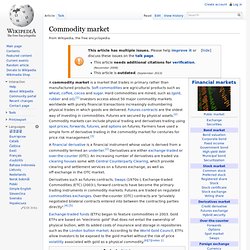
Sumerians first used clay tokens sealed in a clay vessel, then clay writing tablets to represent the amount—for example, the number of goats, to be delivered.[8][9] These promises of time and date of delivery resemble futures contract. Early civilizations variously used pigs, rare seashells, or other items as commodity money. Since that time traders have sought ways to simplify and standardize trade contracts. [citation needed] Gold and silver markets evolved in classical civilizations. Beginning in the late 10th century, commodity markets grew as a mechanism for allocating goods, labor, land and capital across Europe.
Trade credit. Trade credit is the largest use of capital for a majority of business to business (B2B) sellers in the United States and is a critical source of capital for a majority of all businesses.

For example, Wal-Mart, the largest retailer in the world, has used trade credit as a larger source of capital than bank borrowings; trade credit for Wal-Mart is 8 times the amount of capital invested by shareholders.[1] Trade credit is the credit extended by one trader to another for the purchase of goods and services. Trade credit facilitates the purchase of supplies without immediate payment. Trade credit is commonly used by business organisations as a source of short-term financing.It is granted to those customers who have reasonable amount of financial standing and goodwill. There are many forms of trade credit in common use. Various industries use various specialized forms. Example[edit] Trade credit. How to Forecast Revenue and Growth. When starting out, financial forecasts may seem overwhelming.
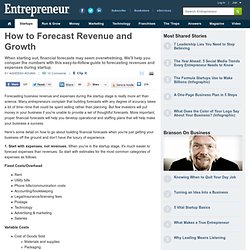
Export Watch Manufacturer Sample Business Plan - Executive Summary. Grutzen Watches is a start-up watch producer and distribution company.

Its strategy is to serve the upscale niche markets of the watch industry. It will capitalize on the German engineering and manufacturing used to build the watches. There are many untapped potential markets within this industry that desire high-quality, stylish goods, but do not think they can afford them or do not know where to purchase them. It is the firm's intention to build and export its products to the United States and to make Grutzen Watches the number one selling European watch in the Western U.S. To do this the company's long-term goals are to to achieve a 20% market share in the U.S, build brand image and brand equity through marketing, achieve a sustainable 55% profit margin, and eventually produce luxury watches in addition to the initial, moderately-priced line.
ONS Home. Output in the Construction Industry, November 2015 In November 2015, output in the construction industry was estimated to have decreased by 0.5% compared with October 2015.
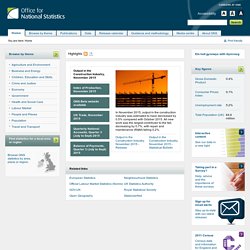
All new work was the largest contributor to the fall, decreasing by 0.7%, with repair and maintenance (R&M) falling 0.2%. Index of Production, November 2015 Production output increased by 0.9% in November 2015 compared with November 2014. Manufacturing output decreased by 1.2% in November 2015 compared with November 2014. ONS Beta website available The ONS have been developing a new website to replace the current version. UK Trade, November 2015. Sales Forecasting. Marketing Study Note Home | Latest Marketing Resources from the tutor2u Blog | Marketing Revision Quizzes Author: Jim Riley Last updated: Sunday 23 September, 2012 Introduction Sales forecasting is a difficult area of management.
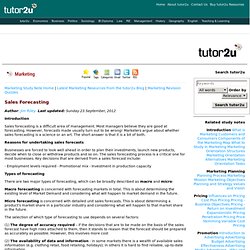
Cost of goods sold. Cost of goods sold or COGS refer to the carrying value of goods sold during a particular period.

Costs are associated with particular goods using one of several formulas, including specific identification, first-in first-out (FIFO), or average cost. Costs include all costs of purchase, costs of conversion and other costs incurred in bringing the inventories to their present location and condition. Costs of goods made by the business include material, labor, and allocated overhead. Bookkeeping. Bookkeeping, in business, is the recording of financial transactions, and is part of the process of accounting.[1] Transactions include purchases, sales, receipts and payments by an individual or organization.
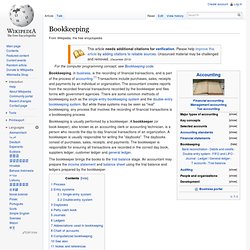
The accountant creates reports from the recorded financial transactions recorded by the bookkeeper and files forms with government agencies. Cash flow forecasting. Cash flow forecasting or cash flow management is a key aspect of financial management of a business, planning its future cash requirements to avoid a crisis of liquidity.
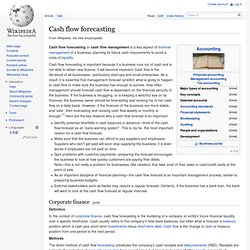
Warranty. Buyers should consider the warranty for their purchase. In contract law, a warranty has various meanings but generally means a guarantee or promise[1] which provides assurance by one party to the other party that specific facts or conditions are true or will happen. This factual guarantee may be enforced regardless of materiality[2] which allows for a legal remedy if that promise is not true or followed.
Although a warranty is in its simplest form an element of a contract, some warranties run with a product so that a manufacturer makes the warranty to a consumer with which the manufacturer has no direct contractual relationship. A warranty may be express or implied, depending on whether the warranty is explicitly provided (typically written) and the jurisdiction. Warranties may also state that a particular fact is true at one point in time or that the fact will be continue into the future (a "promissory" or continuing warranty). Sale of goods[edit] Implied warranty[edit] Product types[edit]
Equity (finance) At the very start of a business, owners put some funding into the business to finance operations. Financial accountancy. Financial accountancy is governed by both local and international accounting standards. Generally Accepted Accounting Principles (GAAP) is the standard framework of guidelines for financial accounting used in any given jurisdiction. Accounts receivable. Overview[edit] Accounts receivable represents money owed by entities to the firm on the sale of products or services on credit. In most business entities, accounts receivable is typically executed by generating an invoice and either mailing or electronically delivering it to the customer, who, in turn, must pay it within an established timeframe, called credit terms[2] or payment terms.
The accounts receivable department uses the sales ledger, because a sales ledger normally records:[3] Asset. In financial accounting, an asset is an economic resource. Anything tangible or intangible that is capable of being owned or controlled to produce value and that is held to have positive economic value is considered an asset. Simply stated, assets represent value of ownership that can be converted into cash (although cash itself is also considered an asset).[1] The balance sheet of a firm records the monetary[2] value of the assets owned by the firm. It is money and other valuables belonging to an individual or business.[1] Two major asset classes are tangible assets and intangible assets.
Tangible assets contain various subclasses, including current assets and fixed assets.[3] Current assets include inventory, while fixed assets include such items as buildings and equipment.[4] Liability (financial accounting)